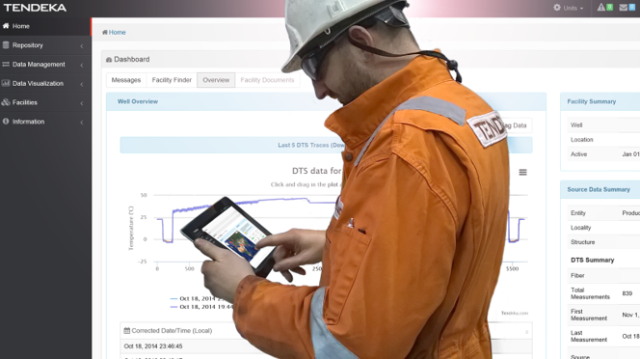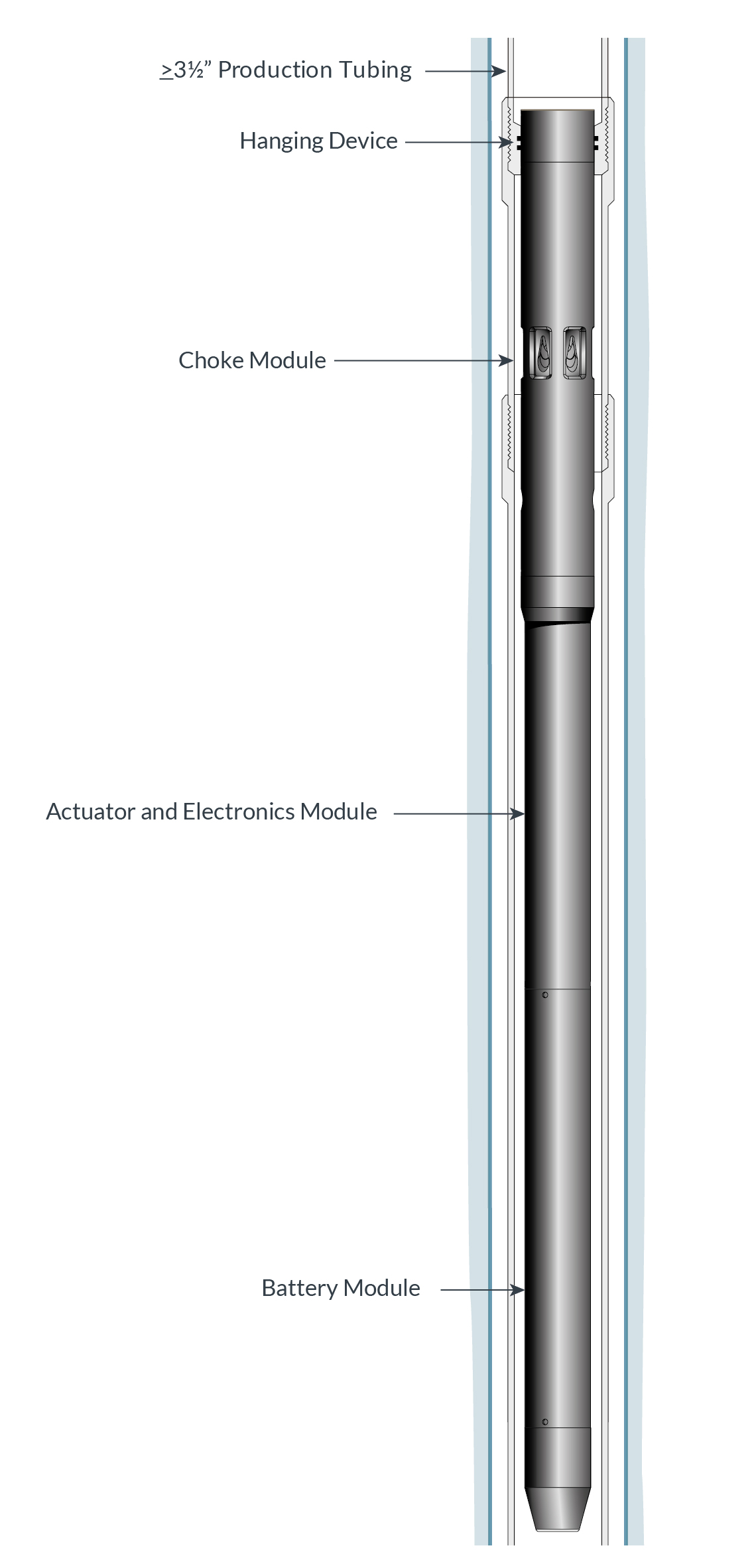
Remote data management is delivered through Tendeka’s DataServer software. (Source: Tendeka)
The concept of the digital oil field is based upon using intelligent software/hardware to perform tasks in the oil field’s upstream sector and to combine these into an automated process from data gathering and decision- making to process and workflow execution. The aim is to improve decision-making to provide an optimal production environment for maximum recovery and increased efficiency.
The industry focus on the digital oil field has been around for some time and was born out of the desire to improve profitability and efficiency by automating much of the processes across the oil field. For this to happen, technology providers must focus on the development of systems that can be integrated into this digital oilfield vision.
Downhole components
The digital oilfield concept has been used in temporary applications such as drilling and well test operations with great success. However, the uptake in permanent completion applications has been low, and even those that have been implemented are often not utilized to the maximum effect.
Significant advancements have recently been made on surface systems, partially due to the overlap with other industries and the role Big Data play in the digital oilfield vision. Downhole components have unfortunately not progressed at the same speed, and new advancements in downhole monitoring and control technology are required to provide in-well production optimization.
The early digital oil field allowed companies to capture more data and have those analyzed in real time or near real time to optimize production and improve well performance. One of the key attributes to this was improving efficiency in decision-making by removing the middle man and delivering the data directly to the right people and into the right models. The vision now is that the digital oil field will take the next step and provide full automation for production optimization by using truly intelligent systems and closing the feedback loop.
Most intelligent downhole monitoring and control equipment used is operated via hydraulic and/or electric control lines that run between the downhole device and surface control system to provide power and communication. These control lines can often limit the completion design and lead to increased cost and complexity. They also have the potential for early and permanent failure, meaning a key component of the digital oil field may be reductant before the well is brought online.
These solutions are targeted toward new field developments, and there are limited options for replacement of failed equipment or equipment for existing wells other than a complete workover.
As discussed previously, there are a variety of digital oilfield solutions on the market for topside applications, and these can be integrated into existing fields to manage data and automate processes. The same cannot be said for downhole solutions, and most of the intelligent equipment on the market does not address the needs of existing assets. Without these retrofittable intelligent downhole systems, the full benefit of the digital oil field is out of reach economically for several mature fields.
Pressure pulse technology
Tendeka has developed a pressure pulse telemetry system that can be applied to downhole devices for communication in flowing wells and used to provide a wireless alternative to existing data transfer and actuation methods.
 The telemetry was first applied to a downhole pressure/ temperature (PT) gauge, creating the PulseEight Wireless Gauge, which expanded the limited functionality of a memory gauge.
The telemetry was first applied to a downhole pressure/ temperature (PT) gauge, creating the PulseEight Wireless Gauge, which expanded the limited functionality of a memory gauge.
This provided a means of adding real-time downhole data from an existing well into reservoir models rather than waiting for the memory gauge to be pulled to surface before analysis could begin.
This led to greatly improved efficiency as it allowed data to be viewed in real time and meant faster decision-making on optimization techniques.
Since then the PulseEight device has been modified and upgraded to include PT monitoring, remote valve actuation and downhole regulation of flow/pressure and has been through an in-depth qualification program.
Tendeka’s PulseEight system is now a modular monitoring and control device with semi-duplex wireless communication.
The device is powered using primary battery cells and can transmit downhole pressure and temperature data to surface as well as act as a remotely operated variable-position flow control valve.
The device is designed to be retrofitted within the production tubing using standard intervention techniques. This allows mature fields and existing wells that have already embraced the digital oil field in their topside infrastructure to install intelligent downhole systems cost-effectively and without a full workover. This enables full reservoir automation for existing assets, reducing the man hours in data analyses/sorting and allowing faster implementation of reservoir optimization techniques.
The PulseEight Wireless Intelligent Completion can be used in several different scenarios, with the possibility of using multiple devices in a single well to provide a range of functionalities, from PT monitoring, interval control, gas hydrate prevention and downhole regulation to simple on/off plugs that can actuate on command or autonomously based on well conditions. Since the valve can be set anywhere in the production tubing using conventional bridge plugs, there is great flexibility and range in the device’s performance objectives.
Tendeka has successfully deployed the PulseEight system in fields across the world, from the Troll Field offshore Norway to the U.S. onshore market. The application of these projects has varied from simple downhole PT monitoring to remote operation of downhole valves.
With a prolonged reduction in global oil prices, the focus has shifted toward optimizing existing assets and extending production life rather than pursuing highcapex new field developments. The initial offering has been designed with the aim of providing retrofittable intelligent completions to address the problems faced in mature fields such as failed permanent completion equipment and outdated/inefficient technology.
Current R&D efforts are focused on expanding the operational envelope of the technology by developing a through-bore option for zonal monitoring and control, which will complement the company’s other lower completion offerings. In addition to this, work is ongoing to build on the intelligence of the existing system with the aim of creating a team of goal-seeking downhole devices to work autonomously, further enhancing the efficiency and performance of intelligent completion equipment for the digital oil field.
Both projects will include focus on extending battery lifetime at downhole conditions to open up the possibility of “life of well” applications for wireless technology.
Recommended Reading
Artificial Lift Firm Flowco’s Stock Surges 23% in First-Day Trading
2025-01-22 - Shares for artificial lift specialist Flowco Holdings spiked 23% in their first day of trading. Flowco CEO Joe Bob Edwards told Hart Energy that the durability of artificial lift and production optimization stands out in the OFS space.
Artificial Lift Firm Flowco Seeks ~$2B Valuation with IPO
2025-01-07 - U.S. artificial lift services provider Flowco Holdings is planning an IPO that could value the company at about $2 billion, according to regulatory filings.
Infinity Natural Resources’ IPO Nets Another $37MM
2025-02-07 - Underwriters of Infinity Natural Resources’ January IPO have fully exercised options to purchase additional Class A common stock at $20 per share.
Utica’s Infinity Natural Resources Seeks $1.2B Valuation with IPO
2025-01-21 - Appalachian Basin oil and gas producer Infinity Natural Resources plans to sell 13.25 million shares at a public purchase price between $18 and $21 per share—the latest in a flurry of energy-focused IPOs.
Venture Global Targets $110B in Massive IPO
2025-01-13 - Venture Global is expected to pitch its IPO to investors by Jan. 17 to rival the largest energy IPOs on record.
Comments
Add new comment
This conversation is moderated according to Hart Energy community rules. Please read the rules before joining the discussion. If you’re experiencing any technical problems, please contact our customer care team.





